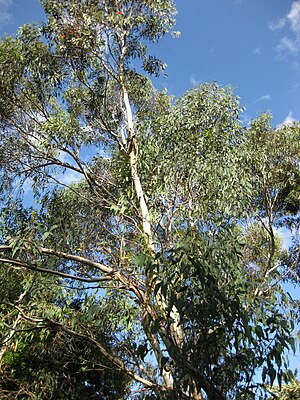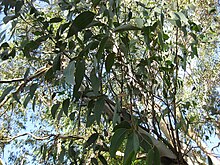Eucalyptus racemosa
| Eucalyptus racemosa | ||||||||||||
|---|---|---|---|---|---|---|---|---|---|---|---|---|

Eucalyptus racemosa |
||||||||||||
| Systematics | ||||||||||||
|
||||||||||||
| Scientific name | ||||||||||||
| Eucalyptus racemosa | ||||||||||||
| Cav. |
Eucalyptus racemosa is a species ofthe myrtle family (Myrtaceae). It occurs in the central and northern part of the coast of New South Wales and in the southern part of the east coast of Queensland , where it is called "Snappy Gum", "Scribbly Gum", "Narrow-leaved Scribbly Gum" or "White Gum".
description
Appearance and leaf
Eucalyptus racemosa grows as a tree that can reach heights of up to 15 meters. The bark is smooth with scribbles, white, gray or yellow, and peels in short ribbons. The bark of the small branches is green. There are no oil glands in the marrow of the young branches or in the bark.
In Eucalyptus racemosa is Heterophyllie ago. The leaves on seedlings are sessile in the first two to five pairs and then - as in young, middle-aged and adult specimens - divided into a petiole and a leaf blade. The slightly different gray-green leaf blade on the top and bottom of seedlings is elliptical to broadly lanceolate with a length of 7 to 13.5 cm and a width of 1.6 to 4.5 cm. In young specimens, the Eucalyptus racemosa subsp. rossii on top and bottom of the same color matt gray-green leaf blade with a length of 10 to 14 cm and a width of 2.5 to 4.5 cm wide-lanceolate to lanceolate. On medium-old specimens, the leaf blade is 9 to 16 cm long and 2 to 2.8 cm wide - lanceolate to lanceolate, straight, with entire margins and dull gray-green. The leaf stalks on adult specimens are 10 to 15 mm long. The leaf blades on adult specimens are glossy green on the top and bottom and are 7 to 15 cm long and 0.8 to 1.5 cm wide, elliptical, lanceolate to narrow-lanceolate, relatively thick, crescent-shaped, tapered towards the base of the spade and have a pointed upper end. The side nerves, which are barely visible, extend from the median nerve at large intervals at an acute or very acute angle. The cotyledons ( cotyledons ) are kidney-shaped.
Inflorescence and flower
On the side of an inflorescence stem with a length of 7 to 12 mm and a width of up to 3 mm in cross-section narrowly flattened or angular inflorescence stem stand together in a simple inflorescence 9 to 15 flowers. The pedicel-round flower stalks are 4 to 6 mm long. The not blue-green floured or frosted flower buds are club-shaped with a length of 3 to 6 mm and a diameter of 2 to 5 mm. The sepals form a calyptra that remains in place until flowering ( anthesis ). The smooth calyptra is hemispherical, shorter than as long as the smooth flower cup (hypanthium) and narrower than or as wide as this. The flowers are white or creamy white. The outer stamens are sterile (infertile). The flowering period of Eucalyptus racemosa subsp. rossii ranges from December to February.
Fruit and seeds
The stalked fruit is 4 to 5 mm long and 5 to 7 mm in diameter pear-shaped or egg-shaped and four-faced. The disc is flat or slightly raised, the fruit compartments are enclosed or at the level of the rim.
In Eucalyptus racemosa subsp. rossii is the brown or red-brown seed is pyramidal or nearly pyramidal and the hilum is terminal.
Occurrence
The natural range of Eucalyptus racemosa is the central and northern coastline of New South Wales and the adjoining southern coastline of Queensland .
Eucalyptus racemosa often occurs locally in sparse hardwood forests on flat, less fertile, sandy soils over sandstone .
Systematics
The first publication of Eucalyptus racemosa was made in 1797 by Antonio José Cavanilles in Icones et Descriptiones Plantarum , Volume 4 (1), 24. The epithet racemosa means traubig. The epithet rossii for the subspecies Eucalyptus racemosa subsp. rossii honors the teacher WJC Ross (1850–1914).
Of Eucalyptus racemosa Cav. there are two subspecies:
- Eucalyptus racemosa Cav. subsp. racemosa , syn .: Eucalyptus micrantha A. Cunn. ex DC. , Eucalyptus signata F.Muell. , Eucalyptus haemastoma var. Micrantha (A. Cunn. Ex DC.) Benth. , Eucalyptus haemastoma var. Capitata Maiden , Eucalyptus haemastoma var. Sclerophylla Blakely , Eucalyptus micrantha var. Signata (F.Muell.) Blakely , Eucalyptus racemosa var. Signata (F.Muell.) RDJohnst. & Marryatt , Eucalyptus sclerophylla (Blakely) LASJohnson & Blaxell , Eucalyptus racemosa Cav. var. racemosa and Eucalyptus racemosus Cav. orth. var.
- Eucalyptus racemosa subsp. rossii (RTBaker & HGSm.) BEPfeil & Henwood , Syn .: Eucalyptus rossii R.T.Baker & HGSm.
use
The wood of Eucalyptus racemosa subsp. rossii is quite brittle and is used to a limited extent, for example to build temporary fences. It is not particularly suitable as firewood.
Individual evidence
- ↑ a b Specimen search results: Eucalyptus racemosa at Australia's Virtual Herbarium. Council of Heads of Australasian Herbaria . Retrieved April 2, 2013
- ↑ a b c APNI = Australian Plant Name Index . Center for Plant Biodiversity Research. Australian Government. last accessed on May 2, 2013
- ↑ a b c d e f g h i j k K. Hill: Eucalyptus racemosa (Cav.) At New South Wales Flora Online . National Herbarium of NSW, Royal Botanic Garden, Sydney. Retrieved April 2, 2013
- ↑ a b c d e f g h i j k l m n Eucalyptus racemosa at EucaLink - A Web Guide to the Eucalypts . last accessed on May 2, 2013.
- ↑ a b c d e f g h i j k Scribbly Gum, Snappy Gum, White Gum - Eucalyptus rossii RTBaker & HGSm. in: DJ Boland, MIH Brooker, GM Chippendale, N. Hall, BPM Highland, RD Johnston, DA Kleinig, MW McDonald & JD Turner (editors): Forest Trees of Australia . CSIRO Publishing. 5th edition 2006. p. 586 online at Google Books . last accessed on May 2, 2013
- ↑ Eucalyptus racemosa at Tropicos.org. Missouri Botanical Garden, St. Louis, accessed April 2, 2013.
- ↑ a b Rafaël Govaerts (Ed.): Eucalyptus racemosa. In: World Checklist of Selected Plant Families (WCSP) - The Board of Trustees of the Royal Botanic Gardens, Kew . Retrieved May 2, 2013.

